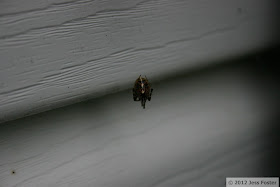No doubt you've seen "cobwebs" around the outside of your house: tangled masses of spider silk with threads going this way and that in an apparently random pattern, having none of the beautiful design of orb weavers' webs. Well, these webs were built by spiders of the species
Parasteatoda tepidariorum (also called
Achaearanea tepidariorum), or the Common House Spider. And that's just what they are: extremely common. And yet, if you take the time to look closely at their bodies, you'll see that, while their webs may look a mess, their abdomens have some intricate patterns. The biggest house spider I've seen built her web between our hot water heater and the wall. On analyzing the photos, I discovered that she's also a new mother, for there are numerous spiderlings crawling around the clump of things that she uses for cover. Behind the cover are two egg sacs; I believe only one has hatched. Each egg sac can contain hundreds of eggs. As usual with spider species, females are larger than males. Females often build their webs near each other, forming a sort of "spider apartment complex," but if they come in contact with other females they'll attack them.
I apologize for the fact that these photos lack crispness. That's the downside of photographing a house spider: the cobweb gets in the way. You'll notice some of the photos are bright: that's due to the flash. I used it only to bring out details otherwise indistinct.
 |
| What exactly this "house" is made of, I really don't know. I see egg sacs, insect parts, wool-like material...Anyway, you can see one of the spiderlings climbing up. They're kind of cute, in a spidery sort of way. |
 |
| One of the characteristics of this spider is that it drops down on a single strand when disturbed out of its "home." |
So, if you see one of these spiders, don't kill it! They are helpful rather than harmful, ridding your yard of pest insects.
http://www.uark.edu/ua/arthmuse//achaeara.html (very good site)
http://entomology.ifas.ufl.edu/creatures/urban/spiders/common_house_spider.htm













No comments:
Post a Comment